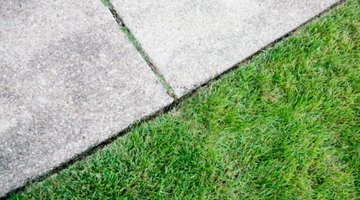How to Install a Sidewalk Drainage System
Installing a sidewalk drainage system helps prevent subsurface water from destabilizing the foundation or causing a sidewalk to crack. Standing water can also cause surfaces to become slick and dangerous.

Installing a drainage system along your sidewalk will improve the longevity of your sidewalk and make the surface safe for people to walk on.
Things You Will Need
- Chalk
- Wooden stakes and string
- Tape measure
- Concrete saw
- Shovel
- Level
- Gravel
- Perforated drainage pipe
- Connectors
- T connectors
- Grid drains
- Landscape fabric
- Sand
- Topsoil
- Grass seed
-
Pour water onto the sidewalk and note where water puddles. Once the surface is dry, draw a chalk circle around the low-lying areas.
-
Mark the appropriate place for excess water to run off. If the sidewalk is near the curb, have the drainage system empty onto the curb. Include the distance from the sidewalk to the drainage outlet in your measurement.
-
Use chalk on the sidewalk and wooden stakes and string on the ground to mark out the path of a drainage trench. The trench will run from the spot where water gathers on the sidewalk to a trench that will run parallel to the sidewalk and empty at the curb. The trench will need to be at least 1 1/2 feet wide so the walls of the trench have an adequate slope.
-
Cut through the trouble area on the sidewalk with a concrete saw. Use the chalk outline as your guide. The trench should be three times as deep as the diameter of the drain pipe. Remove concrete and other debris from the opening.
-
Dig out a drainage trench along the side of the sidewalk, 6 inches away from the sidewalk. The trench will need to have a slope, of 1 percent, or 1 foot for every hundred feet.
-
Pour 2 inches of gravel over the surface of the trench.
-
Place a perforated drainage pipe from the concrete opening to the trench along the sidewalk. Over the sidewalk section, set rectangular grid drains over the opening. They should sit 1 inch below the surface of the sidewalk.
-
Connect the lengths of pipe with connectors. Along the sidewalk trench, use a T connector every 10 feet so excess water can enter the drainage system. The T connectors go upside down so the stem is pointing up to receive water. Place a grid drain over the T connectors.
-
Cover the drain pipes with landscape fabric and coarse gravel. Add a 2-inch layer of sand over the gravel to improve drainage.
Tip
To disguise the drainage system along the sidewalk, only fill the trench with gravel and sand until you are 4 inches from the top. Fill the rest of the trench with topsoil and seed it with native grass seed. Consider planting ornamental grass on the outside of the trench to prevent erosion once root systems develop.
The Drip Cap
- Installing a sidewalk drainage system helps prevent subsurface water from destabilizing the foundation or causing a sidewalk to crack.
- Installing a drainage system along your sidewalk will improve the longevity of your sidewalk and make the surface safe for people to walk on.
- Once the surface is dry, draw a chalk circle around the low-lying areas.
- The trench will need to be at least 1 1/2 feet wide so the walls of the trench have an adequate slope.
- Place a grid drain over the T connectors.
- Cover the drain pipes with landscape fabric and coarse gravel.
References
Resources
Writer Bio
Aurora LaJambre is a writer and editor living in Brooklyn, N.Y. For over five years she's covered topics in culture, lifestyle, travel, DIY design and green living for print and online media. Her publication credits include "WOW Women on Writing," "Six States" and Catalogs.com. She graduated from New York University in 2003 with a Bachelor of Fine Arts in creative writing.
Photo Credits
- Jupiterimages/Creatas/Getty Images
- Jupiterimages/Creatas/Getty Images
More Articles



